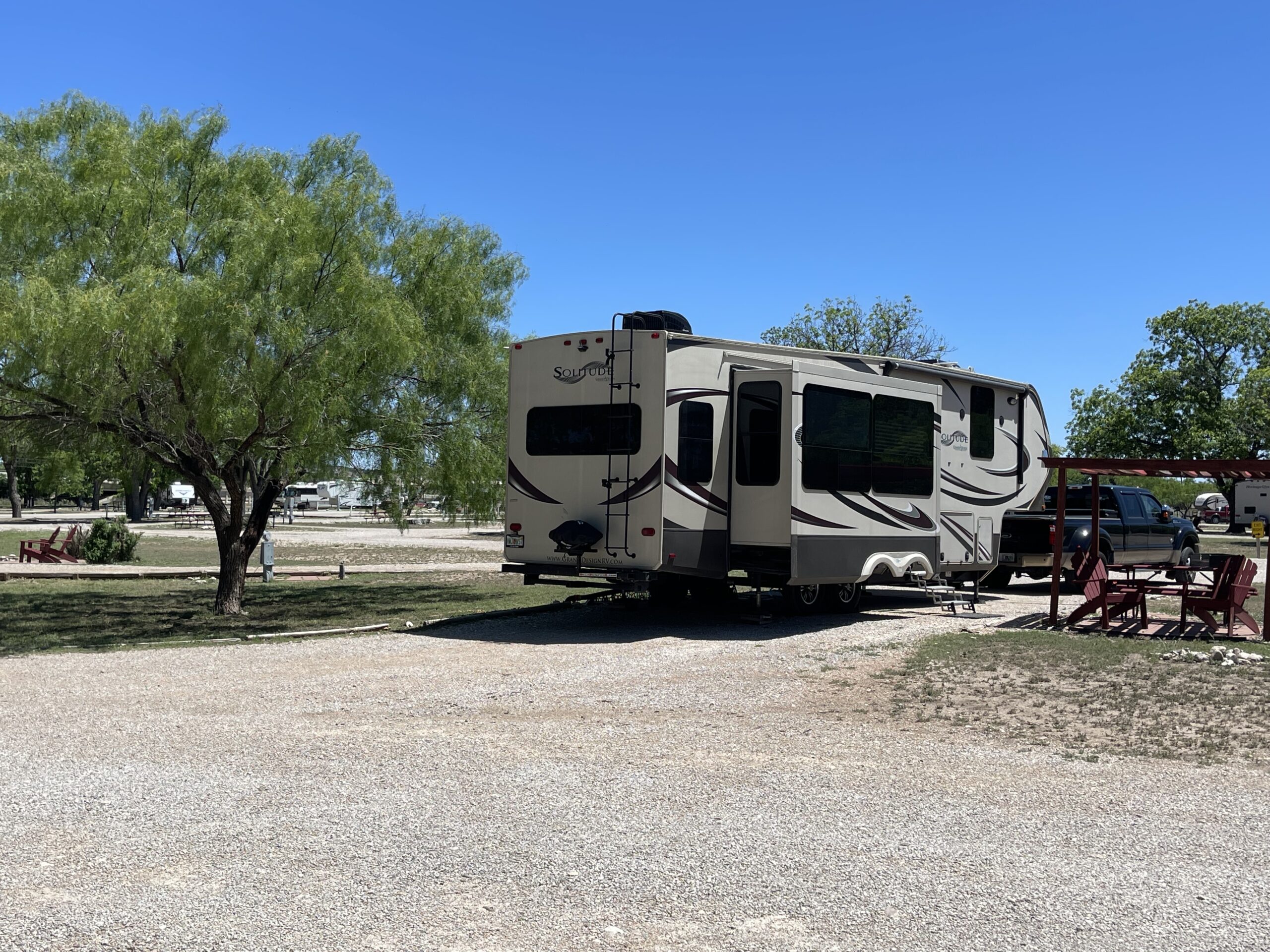
I’ve been fortunate to be getting some fairly nice campsites along my way so far. This site in Junction, TX was particularly noteworthy with its large shade tree and relaxing pergola shaded seating area with a view of the Llano River. Still not quite up to the standards when compared to my home base in Lake Wales, FL, but nice enough to keep me reasonably comfortable. As I continue my trek through TX and NM, I’ve had the opportunity to explore several small town America locations – each having their own bit of charm and legacy. Here are the places I’ve visited during the past few weeks.
Schulenburg, TX
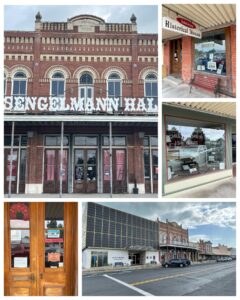 Now this small, 2,500 population town, has a large Czech and German culture to it. Emigrants of German, Austrian, and Czech descent settled here in this rural agricultural town following the Revolution of 1848 in Europe. Much of their culture is still evident in town from the items in the local bakery to the presence of a Czech-Tex restaurant on the first floor of the Sengelmann Hall, to it’s dance hall on the second floor where to this day Polka dances occur each Sunday afternoon. Downtown was small, featuring a chamber of commerce, the aforementioned hall, and a small museum featuring history and artifacts from Schulenburg. Unfortunately it
Now this small, 2,500 population town, has a large Czech and German culture to it. Emigrants of German, Austrian, and Czech descent settled here in this rural agricultural town following the Revolution of 1848 in Europe. Much of their culture is still evident in town from the items in the local bakery to the presence of a Czech-Tex restaurant on the first floor of the Sengelmann Hall, to it’s dance hall on the second floor where to this day Polka dances occur each Sunday afternoon. Downtown was small, featuring a chamber of commerce, the aforementioned hall, and a small museum featuring history and artifacts from Schulenburg. Unfortunately it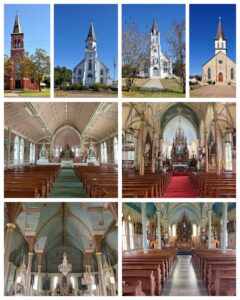 was not open on the day I was visiting.
was not open on the day I was visiting.
The true tourist draw in the area however is what is known as the painted churches. Within roughly an 8×10 mile square, there would be four churches built in the late 1800 to early 1900s. From the outside, they were rather plain looking simple churches. However, the early settlers used inexpensive paint on the inside to give them the wow and pizazz one would find in grand old churches in Europe. These were truly amazing, each having their own distinct look on the inside. Some with angels painted on the ceilings, while others used gold paint to mimic true gold edging, while others were lined with beautiful statues along the center walkway depicting various religious orders. Truly amazing! The collage picture depicted here does not in any way represent the true beauty of these places. I would highly encourage you to follow the link found at the bottom of this blog which will take you to my Flickr photo album where you can see the many full resolution pictures I took in each of these churches. You will not be disappointed!
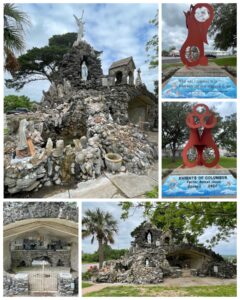 While I was out chasing these painted churches, I also stopped to visit a couple area Roadside America sites. First up in La Grange, TX on the grounds of the Queen of the Holy Rosary Catholic Church was this Lourdes Grotto replica. It stands 20 feet high and 43 feet wide, and was built in 1925 under the direction of Rev. Paul D. Jasper. At the time, there was a rock wall that surrounded the church grounds, and the Rev thought it to be ugly. So he had it torn down, and used the materials to build the grotto. Pretty nice as grottos go.
While I was out chasing these painted churches, I also stopped to visit a couple area Roadside America sites. First up in La Grange, TX on the grounds of the Queen of the Holy Rosary Catholic Church was this Lourdes Grotto replica. It stands 20 feet high and 43 feet wide, and was built in 1925 under the direction of Rev. Paul D. Jasper. At the time, there was a rock wall that surrounded the church grounds, and the Rev thought it to be ugly. So he had it torn down, and used the materials to build the grotto. Pretty nice as grottos go.
Next up was a simple pro-life metal monument that features three baby fetuses and sits in front of the Schulenburg Knights of Columbus chapter. The front side of the base identifies the Knights organization, while another side has the phrase “What was I supposed to be – What were my eyes supposed to see”. Certainly an interesting, if not controversial piece, to be found in small town America. Nicely done Knights!
Junction, TX
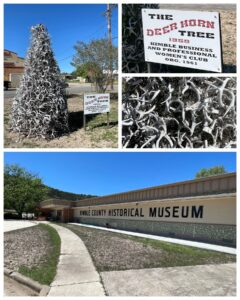 My next stop would take me to the small town known as Junction. Yet another 2,500 population town and frankly, there was not a whole lot to see there, nor within the area 30 miles in any direction. But there was this one Roadside attraction downtown known as the Deer Antlers Horn Tree. Constructed of dear antlers (some including the heads and skulls) in 1968 by the Kimble Business and Professional Women’s Club. The antlers are very white washed these days having been in the hot sun for so many decades. The tree stands about 12 feet tall, and has a metal base upon which the antlers are attached. Certainly an interesting piece.
My next stop would take me to the small town known as Junction. Yet another 2,500 population town and frankly, there was not a whole lot to see there, nor within the area 30 miles in any direction. But there was this one Roadside attraction downtown known as the Deer Antlers Horn Tree. Constructed of dear antlers (some including the heads and skulls) in 1968 by the Kimble Business and Professional Women’s Club. The antlers are very white washed these days having been in the hot sun for so many decades. The tree stands about 12 feet tall, and has a metal base upon which the antlers are attached. Certainly an interesting piece.
Just down the road from the tree was the Kimble County Historical Museum. I arrived at around 2:30pm, and from what I could tell, was the only visitor that day. I received a private tour by one of the docent volunteers who was absolutely delightful and very knowledgeable about the museum and its contents. I was so entertained by her stories as we progressed through the various museum rooms that I neglected to take a single picture inside. Oh well – just suffice to say it contained tons of local history, and lots of interesting stories to go with it. I spent close to two hours in there, actually going past the scheduled closing time of 4pm. I really appreciated the personal one-on-one tour!
Fort Stockton, TX
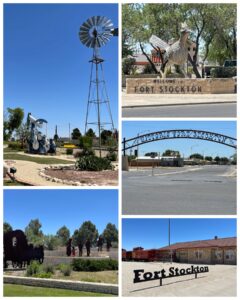 My next stop along the I-10 westerly route would take me to Fort Stockton. One of the more populated towns in this western part of TX along I-10 with upwards of 8,400 residents. There was an actual fort built here in 1859 by the US Army, with a mission to protect settlers, merchants and travelers from American Indian raids. That only lasted for two years to 1861 when Texas seceded from the Union and the fort was abandoned. It was once again occupied in 1867 after the Civil War where it continued to defend the frontier until 1886 at which point most of the American Indians had been driven into Mexico or moved to Oklahoma. The central downtown area had a very nice visitor center located in what was originally the town’s train depot built in 1911. There were lots of metal art work throughout the grounds of the center, an historic welcome sign hanging over Main St, and a large statue of the town’s mascot known as Paisano Pete. Pete was erected in 1980 and at the time was the largest sculptured roadrunner at 20 feet long and 11 feet tall (last summer I saw and reported on the now largest one located in Las Cruces, NM).
My next stop along the I-10 westerly route would take me to Fort Stockton. One of the more populated towns in this western part of TX along I-10 with upwards of 8,400 residents. There was an actual fort built here in 1859 by the US Army, with a mission to protect settlers, merchants and travelers from American Indian raids. That only lasted for two years to 1861 when Texas seceded from the Union and the fort was abandoned. It was once again occupied in 1867 after the Civil War where it continued to defend the frontier until 1886 at which point most of the American Indians had been driven into Mexico or moved to Oklahoma. The central downtown area had a very nice visitor center located in what was originally the town’s train depot built in 1911. There were lots of metal art work throughout the grounds of the center, an historic welcome sign hanging over Main St, and a large statue of the town’s mascot known as Paisano Pete. Pete was erected in 1980 and at the time was the largest sculptured roadrunner at 20 feet long and 11 feet tall (last summer I saw and reported on the now largest one located in Las Cruces, NM).
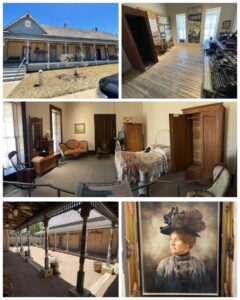 Next I visited the Annie Riggs Memorial Museum. Located in what was once the Koehler Hotel, this single story exposed adobe brick building, with its wrap-around porches and central courtyard, housed fifteen rooms – nine of which were guest rooms. The walls are two feet thick, and the ceilings fourteen feet high. Annie was an employee in the hotel, and in 1904 she purchased it for $5,000. She ran the hotel and boarding house up until her death in 1931. Her heirs continued to operate it, and in 1955, deeded it to the Fort Stockton Historical Society to convert and operate it as a museum – which it did starting in Nov of that year. Each of the rooms feature displays and exhibits depicting the heritage and development of Fort Stockton, while also paying tribute to Annie Riggs. It was noted that she was a tough old broad, and often carried a pistol in her purse to dissuade hotel guests from breaking her rules – mostly related to foul language, drinking, gambling, and the sort. One of the rooms depicted what a typical guest room would look like back in the day (at right, center). Not bad for 50 cents per night!
Next I visited the Annie Riggs Memorial Museum. Located in what was once the Koehler Hotel, this single story exposed adobe brick building, with its wrap-around porches and central courtyard, housed fifteen rooms – nine of which were guest rooms. The walls are two feet thick, and the ceilings fourteen feet high. Annie was an employee in the hotel, and in 1904 she purchased it for $5,000. She ran the hotel and boarding house up until her death in 1931. Her heirs continued to operate it, and in 1955, deeded it to the Fort Stockton Historical Society to convert and operate it as a museum – which it did starting in Nov of that year. Each of the rooms feature displays and exhibits depicting the heritage and development of Fort Stockton, while also paying tribute to Annie Riggs. It was noted that she was a tough old broad, and often carried a pistol in her purse to dissuade hotel guests from breaking her rules – mostly related to foul language, drinking, gambling, and the sort. One of the rooms depicted what a typical guest room would look like back in the day (at right, center). Not bad for 50 cents per night!
 There were a few other notable and historic sites to visit in downtown Fort Stockton. Actually on the south side of I-10 leading into and out of town are these metal silhouette art pieces by New Mexico artist Brian Norwood. On the east side of town stands “March to Fort Stockton” which depicts men of the Ninth US Calvary. On the west side, is “Look To The East” representing a small hunting party of Comanche. Back in downtown I found what is called the “Oldest House” (pictured at right, center) believed to have been built between 1855 and 1860, and served as quarters for a camp merchant, and later during the Civil War served as a shelter for travelers and stagecoach passengers. The Historical Society owns it now, and is taking steps to preserve it. It sure is in bad shape – but then again, it is over 165 years old. Also downtown was the historical Pecos County Courthouse from 1913 (at left, bottom right). Last on the Fort Stockton tour are the remnants of Winfield Army Air Field. I found this listed on Google Maps, but little else is known about it. Best guess is that it was used an and auxiliary air field during World War II to Gibbs Field (now the present-day Fort Stockton Airport), which itself was used for pilot training. Not much left of this hanger either, and no sign of anything resembling a runway.
There were a few other notable and historic sites to visit in downtown Fort Stockton. Actually on the south side of I-10 leading into and out of town are these metal silhouette art pieces by New Mexico artist Brian Norwood. On the east side of town stands “March to Fort Stockton” which depicts men of the Ninth US Calvary. On the west side, is “Look To The East” representing a small hunting party of Comanche. Back in downtown I found what is called the “Oldest House” (pictured at right, center) believed to have been built between 1855 and 1860, and served as quarters for a camp merchant, and later during the Civil War served as a shelter for travelers and stagecoach passengers. The Historical Society owns it now, and is taking steps to preserve it. It sure is in bad shape – but then again, it is over 165 years old. Also downtown was the historical Pecos County Courthouse from 1913 (at left, bottom right). Last on the Fort Stockton tour are the remnants of Winfield Army Air Field. I found this listed on Google Maps, but little else is known about it. Best guess is that it was used an and auxiliary air field during World War II to Gibbs Field (now the present-day Fort Stockton Airport), which itself was used for pilot training. Not much left of this hanger either, and no sign of anything resembling a runway.
Fort Stockton Footnote: So, I arrived in Fort Stockton on Friday afternoon, and spent the better part of Saturday visiting all the places described above. During these travels, I noticed my truck was making an unusual sound when engaging the turbo booster. By the end of the day, I had a check engine light appear. I pulled the codes and it had several – one of which pointed to the turbo charger. So, here I was once again, seemingly stranded in town with a disabled truck. Fortunately, there was a Ford dealership in downtown Fort Stockton (good thing as the next closest one was over 75 miles away). Sadly, they were not open on the weekends so I would have to wait until Monday, which as it was, was the day I was scheduled to leave. So, I checked with the campground office and was able to extend my stay for a couple of days to provide time to have the truck diagnosed and hopefully fixed. I was there at the dealership Monday bright and early at 8:00 am when they opened, where I pleaded my desperate case. They were gracious to work me into their schedule. After a several hour wait to have the diesel mechanic look at the truck, the service manager came out to tell me I had a cracked scorpion hose. I had absolutely no idea what that was, but on the bright side, a broken hose sure does sound cheaper to fix than replacing a turbo charger. Turns out it was. About $150 for the new hose which they had in stock, and $150 for an hour of labor to install it and I was outa there for $300 all in. Now I’m back to being a happy camper! I departed a day late on Tuesday for my next stop to Carlsbad, NM. So, all in all, a pretty good outcome that sure could have been a whole lot worse in terms of both time and $s. I guess driving an 11 year old truck does have risks for these types of age-induced failures. But I sure do hope this is the last of the issues for this trip.
weekends so I would have to wait until Monday, which as it was, was the day I was scheduled to leave. So, I checked with the campground office and was able to extend my stay for a couple of days to provide time to have the truck diagnosed and hopefully fixed. I was there at the dealership Monday bright and early at 8:00 am when they opened, where I pleaded my desperate case. They were gracious to work me into their schedule. After a several hour wait to have the diesel mechanic look at the truck, the service manager came out to tell me I had a cracked scorpion hose. I had absolutely no idea what that was, but on the bright side, a broken hose sure does sound cheaper to fix than replacing a turbo charger. Turns out it was. About $150 for the new hose which they had in stock, and $150 for an hour of labor to install it and I was outa there for $300 all in. Now I’m back to being a happy camper! I departed a day late on Tuesday for my next stop to Carlsbad, NM. So, all in all, a pretty good outcome that sure could have been a whole lot worse in terms of both time and $s. I guess driving an 11 year old truck does have risks for these types of age-induced failures. But I sure do hope this is the last of the issues for this trip. 
Carlsbad, NM
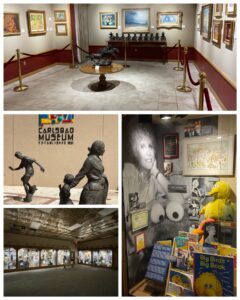 Carlsbad was the first stop since my departure in mid Apr where I got to slow my pace down a bit, and spend an entire week in one location – well actually only six days due to the aforementioned truck issue. But it was nice alternating days between playing tourist, with those where I just hung out at the campground and relaxed. On one of my tourist days, I visited the Carlsbad Museum. It was divided into two sections – one featuring notables from town and historical artifacts, and the other section was devoted to art. Of particular note was one of the Carlsbad natives, Anna Jane Hays (at left, bottom right) who was a graduate of Carlsbad High School, and the University of New Mexico. She was a writer and editor from her high school and college newspapers. After graduating, she wrote for a newspaper in Hollywood, then off to DC as a Public Information Officer for the Peace Corps. She was invited to work for the Children’s Television Workshop and Sesame Street in New York to help develop storybooks and other materials. She was the founding editor of the Sesame Street Magazine, and worked her way
Carlsbad was the first stop since my departure in mid Apr where I got to slow my pace down a bit, and spend an entire week in one location – well actually only six days due to the aforementioned truck issue. But it was nice alternating days between playing tourist, with those where I just hung out at the campground and relaxed. On one of my tourist days, I visited the Carlsbad Museum. It was divided into two sections – one featuring notables from town and historical artifacts, and the other section was devoted to art. Of particular note was one of the Carlsbad natives, Anna Jane Hays (at left, bottom right) who was a graduate of Carlsbad High School, and the University of New Mexico. She was a writer and editor from her high school and college newspapers. After graduating, she wrote for a newspaper in Hollywood, then off to DC as a Public Information Officer for the Peace Corps. She was invited to work for the Children’s Television Workshop and Sesame Street in New York to help develop storybooks and other materials. She was the founding editor of the Sesame Street Magazine, and worked her way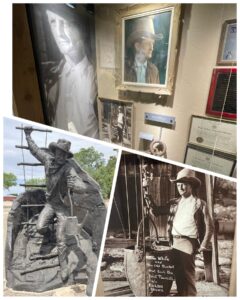 to become Vice President of Book Publishing – culminating in a 29 year career with them. Quite a remarkable woman.
to become Vice President of Book Publishing – culminating in a 29 year career with them. Quite a remarkable woman.
Also featured in the museum was a section dedicated to James Larkin “Jim” White. He was only 16 in 1898 when he was out riding his horse out in the wilderness when he thought he spotted smoke in the distance, only to discover thousands of bats streaming out of the mouth of a nearby cave. He returned days later with a handmade ladder to descend into the deep cavern, and began exploring and chronicling what would become Carlsbad Caverns National Park. He wasn’t the first person to discover the cavern, but it was his determined exploration and promotion of the cave that led to the 1930 National Park designation. In the early years of his exploration, Jim White worked as a mining foreman for a fertilizer company that mined guano (another word for bat poop) in the cave. Ever eager to share his underground playground, it was said he would use a guano bucket to lower curious visitors into the cave for private tours. When the caverns eventually became the National Park, White became its first ranger and guide working for the National Park Service. There is also a nice 14-foot tall bronze statue in front of the Carlsbad National Cave and Karst Research Institute depicting him climbing into the cave with his ladder that was homemade from sticks and fence wire, and an oil can with a rag burning in the spout for light. I can’t even imagine doing what he did back in the early 1900s, but it was through his explorer curiousity that eventually brought us the wonders of Carlsbad Caverns.
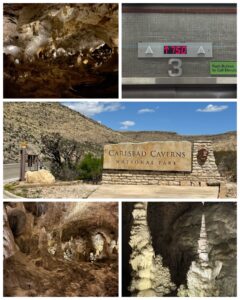 So, while on the subject of Carlsbad Caverns, I was pleased to to check off another National Park from my bucket list and visited the place Jim White discovered and explored. Wow – what an absolutely amazing cavern! First off, the showcase chamber, named simply the Big Room, is 4,000 ft long, 625 feet wide, and 255 feet high in his highest point. These dimensions give the Big Room the award as being the largest single room chamber in the country. And yes, it is massive! Oddly though it is only the 32nd largest in the world – meaning there are 31 other chambers even bigger than this one which is absolutely mind blowing. The cavern was designated as Carlsbad Cave National Monument in 1923 by President Calvin Coolidge, then in 1930, the US Congress changed it to a National Park. All in, the park now includes over 46,000 acres, and over 100 other caves. When I visited the cavern, I took the elevator down to the base entrance. The elevator does not count down by floors, but rather by feet. It’s 750 feet down into the mountain where you will find the base of the cavern. I can’t say enough how this college picture does not do justice the the sheer magnitude and beauty of these caverns.
So, while on the subject of Carlsbad Caverns, I was pleased to to check off another National Park from my bucket list and visited the place Jim White discovered and explored. Wow – what an absolutely amazing cavern! First off, the showcase chamber, named simply the Big Room, is 4,000 ft long, 625 feet wide, and 255 feet high in his highest point. These dimensions give the Big Room the award as being the largest single room chamber in the country. And yes, it is massive! Oddly though it is only the 32nd largest in the world – meaning there are 31 other chambers even bigger than this one which is absolutely mind blowing. The cavern was designated as Carlsbad Cave National Monument in 1923 by President Calvin Coolidge, then in 1930, the US Congress changed it to a National Park. All in, the park now includes over 46,000 acres, and over 100 other caves. When I visited the cavern, I took the elevator down to the base entrance. The elevator does not count down by floors, but rather by feet. It’s 750 feet down into the mountain where you will find the base of the cavern. I can’t say enough how this college picture does not do justice the the sheer magnitude and beauty of these caverns.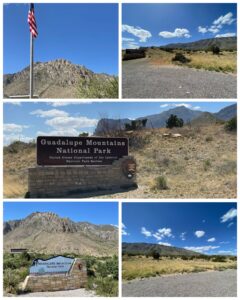 Please do follow the link at the bottom of this blog for my full res pictures – which even those do not fully represent how truly majestic this place is.
Please do follow the link at the bottom of this blog for my full res pictures – which even those do not fully represent how truly majestic this place is.
Some 42 miles south west from Carlsbad Caverns, and back in the state of Texas, is another National Park – called Guadalupe. Filled with beautiful mountain ranges, deep canyons, and a variety of plant and animal life, this National Park sets out to preserve the remote wilderness of the American West. Guadalupe Peak, at 8,751 feet, is the highest peak in the state of Texas. There are over 80 miles of trails offering hiking and backpacking opportunities, as well as 10 wilderness campgrounds where you can pitch a tent. I went to the Pine Springs Visitor Center where I got a nice overview of the park. Being that I’m not much of a hiker or mountain climber, and the fact that the area is filled with such wonders as prickly cacti, rattlesnakes, scorpions, and centipedes, I opted to limit my tour of this National Park to just the visitor center. Besides, there are no scenic drives through the mountains as the intent is to preserve and protect the area to its purest state. But that’s ok – I got a few nice pictures of the mountain range, and I was happy with that.
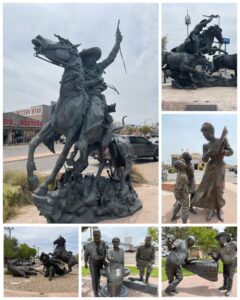 Next up was a visit to the town of Artesia – some 40 miles north of Carlsbad. It was Roadside America that brought me there to see a handful of attractions, but what I also found was actually a really cool little 8,000 person thriving town. Roadside told of several bronze statues located throughout the town depicting various early frontier life and notable people. They didn’t have any details of the locations of each of the statues, so I stopped by the Chamber of Commerce who gladly provided me with a handful of materials, including a walking tour of the town with locations of all notables. So I used that as a guide and was able to locate all 9 of the bronze statues. They were amazing! Beautifully done with many featured prominently in the center of a traffic circle. The sculptures are divided into three categories representing three historic periods of the towns evolution. First was the Cattle Drive series – three statues representing the ranching industry that began in the late 1800s. Next was the Foundation series – representing education which the town takes seriously and has as one of its pillars of
Next up was a visit to the town of Artesia – some 40 miles north of Carlsbad. It was Roadside America that brought me there to see a handful of attractions, but what I also found was actually a really cool little 8,000 person thriving town. Roadside told of several bronze statues located throughout the town depicting various early frontier life and notable people. They didn’t have any details of the locations of each of the statues, so I stopped by the Chamber of Commerce who gladly provided me with a handful of materials, including a walking tour of the town with locations of all notables. So I used that as a guide and was able to locate all 9 of the bronze statues. They were amazing! Beautifully done with many featured prominently in the center of a traffic circle. The sculptures are divided into three categories representing three historic periods of the towns evolution. First was the Cattle Drive series – three statues representing the ranching industry that began in the late 1800s. Next was the Foundation series – representing education which the town takes seriously and has as one of its pillars of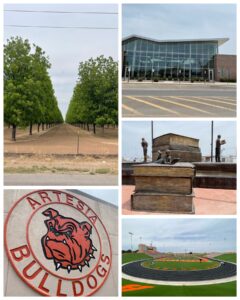 strength. Last up is the Derrick Floor and Oilfield Pioneer series – which showcases the towns major industry of oil and gas which started in the mid 1920s and remains active to this day.
strength. Last up is the Derrick Floor and Oilfield Pioneer series – which showcases the towns major industry of oil and gas which started in the mid 1920s and remains active to this day.
There were certainly a few notable other attractions to be found in Artesia. First, they have one of the most exquisite libraries I’ve ever seen. Such an amazing building with beautiful artwork both inside and outside, clearly demonstrating the importance of education in this town. Besides cattle and oils & gas, farming is another important industry here, with a large dairy industry and even pecans – with acres of rowed pecan trees lining the town. When I was chatting with the nice woman from the Chamber of Commerce, she asked me if I like football. She encouraged me to make a visit to their high school football field – something that this small 8,000 person town was extremely proud of. That suggestion would take me to perhaps the most notable find in this town. The Artesia Bulldogs have a sports complex stadium consisting of a track and football field that is one of the nicest I’ve ever seen at the high school level. It was absolutely amazing and it’s no wonder why they are so proud of it. Well done Artesia!
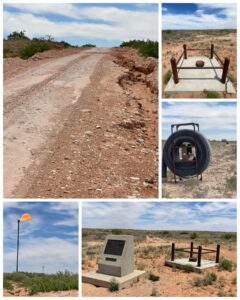 My final adventure during my stay in Carlsbad would take me 30 miles to the east to a site called Project Gnome – purported to be the most accessible atomic explosion site in the U.S. Accessible is somewhat misleading as you have to travel 5 miles on nasty, bumpy, almost impassible dirt roads that are also washed out in many areas. It was certainly slow going – taking me about an hour to traverse the 5 miles there and back! But, it was an interesting, if not somewhat underwhelming find. In 1961, the Atomic Energy Commission exploded a three-kiloton bomb 1,200 feet below the surface in what was an underground salt field. They believed the explosion would melt the salt making it super hot, then use that heat to turn water into steam that in turn could be piped to turbines to generate electricity. Geez – what the hell were they smoking? Following the explosion, steam and smoke poured from the resulting hole but was, can you guess, radioactive – making the experiment useless and rendering the site off-limits for quite some time. The hole was eventually plugged and this plaque and monument now marks the spot. I didn’t stay long as I did not want to glow after my visit. As an aside, as I was slowly driving down the 5 miles of dirt roads, I passed lots of oil fields along the way where I saw several of these fire torch things. I also saw these spools of hose about every 100 yards or so. I was curious about both, and on my way out happened to cross paths with what seemed to be an oilman in a pickup truck driving past me from the opposite direction. I flagged him down, and asked about these two curious things. He was very gracious and filled me in – that is after he laughed at the fact that I had just driven all the way out to see the Project Gnome site. Anyway, the fire torch is called a Flare Stack, and is used as a gas combustion device to burn up, rather than release, combustible gas that is produced as a byproduct of extracting oil. The hoses are used to bring fresh water to a site many miles away during the fracking process. Rather than the water trucks having to traverse that 5 mile nasty road, they essentially run a series of connected hoses several miles in length to the main road, and bring the water to the site that way. Very clever!
My final adventure during my stay in Carlsbad would take me 30 miles to the east to a site called Project Gnome – purported to be the most accessible atomic explosion site in the U.S. Accessible is somewhat misleading as you have to travel 5 miles on nasty, bumpy, almost impassible dirt roads that are also washed out in many areas. It was certainly slow going – taking me about an hour to traverse the 5 miles there and back! But, it was an interesting, if not somewhat underwhelming find. In 1961, the Atomic Energy Commission exploded a three-kiloton bomb 1,200 feet below the surface in what was an underground salt field. They believed the explosion would melt the salt making it super hot, then use that heat to turn water into steam that in turn could be piped to turbines to generate electricity. Geez – what the hell were they smoking? Following the explosion, steam and smoke poured from the resulting hole but was, can you guess, radioactive – making the experiment useless and rendering the site off-limits for quite some time. The hole was eventually plugged and this plaque and monument now marks the spot. I didn’t stay long as I did not want to glow after my visit. As an aside, as I was slowly driving down the 5 miles of dirt roads, I passed lots of oil fields along the way where I saw several of these fire torch things. I also saw these spools of hose about every 100 yards or so. I was curious about both, and on my way out happened to cross paths with what seemed to be an oilman in a pickup truck driving past me from the opposite direction. I flagged him down, and asked about these two curious things. He was very gracious and filled me in – that is after he laughed at the fact that I had just driven all the way out to see the Project Gnome site. Anyway, the fire torch is called a Flare Stack, and is used as a gas combustion device to burn up, rather than release, combustible gas that is produced as a byproduct of extracting oil. The hoses are used to bring fresh water to a site many miles away during the fracking process. Rather than the water trucks having to traverse that 5 mile nasty road, they essentially run a series of connected hoses several miles in length to the main road, and bring the water to the site that way. Very clever!
 I thanked the oilman for his kindness in indulging my obscure curiosity and, as I was about to drive away, he asked me if I had heard of WIPP. I mentioned that I had seen a few signs with that name on it in the area, but knew nothing about it. He indicated it was nearby and suggested I do a drive by to check it out. WIPP stands for Waste Isolation Pilot Plant and is operated by the Department of Energy. It is the only U.S. and only the world’s third (the other two are in Germany) deep geological repository licensed to store radioactive waste for 10,000 years. Great – another opportunity to get my glow on! Actually, the facility does not conduct tours, and you really can’t get too close to it other than afar on the main access road to snap a few pics. It started operating in 1999, and has storage rooms over 2,000 feet deep carved out of the salt beds formed millions of years ago. The basin foundation is comprised of over 3,000 ft of impermeable material, primarily salt, making the site ideal for safe long term storage of radioactive waste. The geek in me certainly would have enjoyed actually taking a tour of the place, but the realist in me recognizes that’s probably not a good idea. As luck would have it, right next door to the campground I was staying in was the national office of the WIPP organization. Outside in the parking lot (at right, bottom left) they had a mock up of what a radioactive waste container looks like, that is then placed into the storage facility. Sadly, the cutout window that shows the inside which also contains some write ups about the device is severely weathered, making visibility in through it virtually impossible. But, I at least got a look at what a container looks like that goes into storage. Certainly interesting.
I thanked the oilman for his kindness in indulging my obscure curiosity and, as I was about to drive away, he asked me if I had heard of WIPP. I mentioned that I had seen a few signs with that name on it in the area, but knew nothing about it. He indicated it was nearby and suggested I do a drive by to check it out. WIPP stands for Waste Isolation Pilot Plant and is operated by the Department of Energy. It is the only U.S. and only the world’s third (the other two are in Germany) deep geological repository licensed to store radioactive waste for 10,000 years. Great – another opportunity to get my glow on! Actually, the facility does not conduct tours, and you really can’t get too close to it other than afar on the main access road to snap a few pics. It started operating in 1999, and has storage rooms over 2,000 feet deep carved out of the salt beds formed millions of years ago. The basin foundation is comprised of over 3,000 ft of impermeable material, primarily salt, making the site ideal for safe long term storage of radioactive waste. The geek in me certainly would have enjoyed actually taking a tour of the place, but the realist in me recognizes that’s probably not a good idea. As luck would have it, right next door to the campground I was staying in was the national office of the WIPP organization. Outside in the parking lot (at right, bottom left) they had a mock up of what a radioactive waste container looks like, that is then placed into the storage facility. Sadly, the cutout window that shows the inside which also contains some write ups about the device is severely weathered, making visibility in through it virtually impossible. But, I at least got a look at what a container looks like that goes into storage. Certainly interesting.
Final Thoughts
 Well, that will bring this edition of the Luv2RV blog to an end. I’ve got two more stops in NM, then its off to AZ where I’ll spend six weeks exploring all that it has to offer. I’ll also meet up with a dear friend and former workmate there whom I’ve not seen in something like 20 years. I’m really looking forward to that. I’m now roughly 4 weeks into my 31-week nomadic adventure, and time already appears to be passing by quickly. But I’m taking it day-by-day and thoroughly enjoying myself as I go. I’ve got plenty of interesting adventures coming up, as well as reconnecting with lots of friends and family during this trip. As always, I appreciate all of you that follow along with my adventures. Till next time, stay well and safe travels.
Well, that will bring this edition of the Luv2RV blog to an end. I’ve got two more stops in NM, then its off to AZ where I’ll spend six weeks exploring all that it has to offer. I’ll also meet up with a dear friend and former workmate there whom I’ve not seen in something like 20 years. I’m really looking forward to that. I’m now roughly 4 weeks into my 31-week nomadic adventure, and time already appears to be passing by quickly. But I’m taking it day-by-day and thoroughly enjoying myself as I go. I’ve got plenty of interesting adventures coming up, as well as reconnecting with lots of friends and family during this trip. As always, I appreciate all of you that follow along with my adventures. Till next time, stay well and safe travels.
I only show a sampling of my adventure pictures here in the blog, and do so mostly in collage format for brevity and ease of reading. If you want to view an album containing individual full fidelity and hi-res images of all my travel pictures related to this specific blog, click the image below. Enjoy!

I can see why the oil man laughed at you driving all the way to the Gnome Project on a questionable road. Those churches are amazing and in such good shape. Glad your truck issue was relatively minor. I am also happy that I can now read your blogs without the use of glasses, this is how cataract surgery is supposed work (I will still need glasses to see things far away)
Yea maybe visiting the Gnome Project site was risky, but I have a big powerful truck and figured I’d make it ok. But it was definitely sketchy. I’m really glad to hear your cataract surgery went well, and you’ve now got super vision in that eye. I’ll bet it makes all the difference in the world now for things like driving and such. I guess you and I will be permanent members of the one good eye club.
Awesome blog as usual. The churches were incredible. All Catholic? Do they “switch” between churches or are there that many patrons of each diocese to maintain each church.
Sorry about the truck. Good thing, not nearly as costly (money and/or time) as last time.
All in all, very interesting log. Annie’s Hotel, the nuclear test and storage facility. And, Carlsbad Caverns…simply amazing.
Keep trucking, and above all, enjoy yourself. And, keep the great blogs going.
Safe Travels.
Thanks for the comments Doug. The four churches that I visited are in fact all Catholic. There are two others that were out of my area that I did not visit, one of which is Lutheran. That’s a really good question regarding patronage. The four I visited are not that far from each other, and the area is most certainly rural. So there can’t be a lot of church goers available to fully support all of them. I suspect given their touristy nature, donations are probably also part of their revenue stream. They certainly were amazing!
I’ll keep on enjoying myself and blogging as I go. I’m having way too much fun to stop anytime soon.
As usual, lots of interesting sites, well described and pictured.
Andy, Martha and I are planning a road trip to AX in a month. I would be interested in the AZ sites you plan to visit, as I am sure we might like to visit many of them as well.
Rick
Hi Rick – nice to hear from you. Thanks for the comments. Glad to hear you are still traveling and enjoying yourself. As for things to see, I use a few resources to help guide me to things that are of interest to me. Trip Advisor has Top Attractions lists which point you to the more common and touristy destinations. For the less known and perhaps more obscure things to see, I use Roadside America and Atlas Obscura to find those. Each have websites you can use, or better yet, apps to put on your phone (Roadside is only available on Apple devices as of this writing). I hope this helps for your trip to AZ. Have fun!
What fun! I think Dave has actually had a tour of the WIPP site – if not that one, then another one of the same concept.
Enjoy the weekend and continued safe travels!
MG
What fun indeed! I’m having more fun than anyone should be allowed. I’m happy to hear, and somewhat jealous Dave got a tour of a WIPP site. I just think it would be really interesting to see how all that works in person. Maybe someday!
Bruce, Will this always be an electronic blog. Just wondering how future generations will access all this great information, pictures and videos. Paula